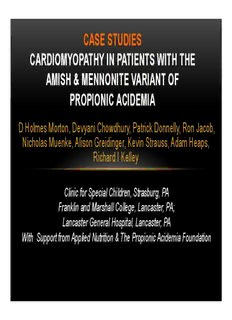
Cardiomyopathy in Patients with the Amish & Mennonite Variant of Propionic Acidemia PDF
Preview Cardiomyopathy in Patients with the Amish & Mennonite Variant of Propionic Acidemia
CASE STUDIES CARDIOMYOPATHY IN PATIENTS WITH THE AMISH & MENNONITE VARIANT OF PROPIONIC ACIDEMIA D Holmes Morton, Devyani Chowdhury, Patrick Donnelly, Ron Jacob, Nicholas Muenke, Alison Greidinger, Kevin Strauss, Adam Heaps, Richard I Kelley Clinic for Special Children, Strasburg, PA Franklin and Marshall College, Lancaster, PA; Lancaster General Hospital, Lancaster, PA With Support from Applied Nutrition & The Propionic Acidemia Foundation BACKGROUND • Propionic acidemia (PA) is found in Amish & Mennonite populations throughout North America. PCCB c.1606A>G is a European variant with significant residual enzyme activity. • Neonatal presentations are infrequent with this variant. Keto-acidotic crises with recurrent vomiting, tachypnea, encephalopathy, seizures, & metabolic strokes typically develop during infectious illnesses. An injured infant may become acutely hypotonic with poor head and trunk control followed by generalized dystonia. The basal ganglia are targeted & show increased T2-signal with low-diffusion immediately after crisis, then, volume loss, scarring, and worsening hypertonic dystonia. • At least 25% patients develop heart failure, which often presents at the end of minor respiratory tract illnesses without keto-acidosis. End stage PA heart disease is a dilated, thin-wall myocardium with endocardial fibroestosis. BIOCHEMISTRY-1: DIAGNOSIS • PCCB c.1606A>G has significant residual enzyme activity, blood propionyl- carntine levels are low, but MS/MS Newborn Screening is usually positive. • Propionyl-CoA forms within mitochondria by oxidation of 4-amino acids & odd chain fatty acids. Propionyl-carnitine is formed in mitochondria by an acyl-transferase & propionyl-CoA. • The propionyl-carnitine levels in myocardium are >1000 times higher than blood. Amino acids & odd chain fatty acids transported into myocardium & oxidized. • Urine organic acids by GC/MS have diagnostic levels of methylcitrate. 3- OH-propionate is present. Propionyl-glycine is usually absent. Glycine concentrations in plasma are high but, unlike methylcrotonylglycineuria, glycine conjugation is not a significant excretion pathway. METHODS & OBSERVATIONS • Patients (age 10.2 ± 5.6 years, n=33) homozygous for PCCB c. 1606A>G were followed at our Clinic for 250 patient-years. • We routinely monitored cardiac morphology, LV ejection fraction, QTc , selected citric acid metabolites by GC/MS, plasma amino acids by HPLC, propionyl-carnitine by MS/MS, and, more recently, serum Coenzyme Q levels. • Two teenage brothers developed symptomatic cardiomyopathy were treated to lower tissue propionyl-CoA and restore citric acid cycle anaplerosis. PA: Underlying & Overt Myocardial Dysfunction • Among PA patients LV ejection fraction (64 ± 11%) was lower than controls (73 ± 5%; p<0.0001). • LV-EF <3SD below controls) developed in 12 (36%) PA patients, ranged from mild (EF 58%) to severe (EF 7%). • Heart failure was fatal in three children. • In the 2 brothers with cardiomyopathy LV ejection decreased from normal to 18% and 42%. • On the metabolic therapy outlined above, LV-EF increased from slowly from 18% to 56% over 4-6 months, and, from 42% to 63% over 1 month. Reduction in the risk of Heart Failure is shown for each 1% increase in ejection fraction. • HOW CAN MYOCARDIAL DEPRESSION BE REVERSED? • A 32-year-old Amishman presented with dilated cardiomyopathy and was found to be homozygous for the PCCBc.1606G>A mutation. He was only able to achieve 81% predicted ETT. Two of his brothers died at ages 21 & 24 years undiagnosed – one suddenly, the other from CHF. • Cardiac MRI confirmed 44% LV-EF, normal wall thickness, & an absence of myocardial fibrosis – despite long standing cardiomyopathy. • Baseline Speckle-Track Echo showed diffuse wall movement abnormalities. RECOVERY • Magnetic resonance imaging showed biventricular dysfunction with increased end diastolic volumes but myocardial interstitial volume fraction was normal 26%. • After recovery of LV-EF, CMR documented normal biventricular function, cardiac volumes, and absence of fibrosis. • Myocardial interstitial volume fraction was normal-29%. • After recovery & on therapy the 17-year-old achieved predicted exercise - a targeted HR of 200 bpm. • Before CoQ his EKG showed prolonged QTc, which shortened with exercise, and inverted T-waves in V5&6. QTC >460 MS INCREASED WITH AGE ABRUPT DECREASE IN LVEF 58 > 43% SINUS BRADYCARDIA, POOR R-WAVE PROGRESSION, DEPRESSED ST SEGMENTS IN INFERIOR & LATERAL LEADS, QTC 431 MSEC
Description: